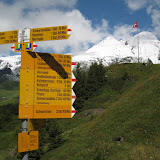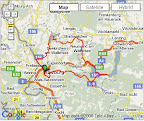 |
| Rosenlaui |
When I first accepted my Munich assignment, I sort of had this vision that I'd get a nice big apartment, and I'd have plenty of friends come to visit. To my surprise, all through the best travel season (June, July, etc), I had no visitors. Then this past week, Phil Sung, my former intern arrived for a visit. Apparently, when he asked me for suggestions 6 months ago, I mentioned Rosenlaui, and Phil was kind enough to get reservations for him and me. I've visited Rosenlaui 3 times now, on all previous tour of the Alps, but each time was for one night each, and being on a bicycle tour, we just rode through.
We decided to drive up, instead of taking the train. This theoretically would take us less time, and give us more flexibility, and cost less. In practice, with better planning we could have saved some time and money, but we would have had to give up a wonderful meal at the Lammi restaurant, and I guess that's worth a little bit of money.
The drive was interesting, and I got to ues my GPS' navigation function --- interestingly enough, this was the first time I compared it head to head against Google Maps, and found that the Garmin City Navigator NT was quite a bit better --- every time the two disagreed, Garmin's directions were much more likely to follow the "official designated route" as shown by the highway authorities.
We arrived at the Lammi Restaurant at 1:00pm, and had the wonderful home made brat-wurst with Noodles. This is the place that made all other sausages (yes, even many German sausages) a disappointment, and we thoroughly enjoyed the wonderful meal and ordered ice cream after wards to top it off. We then headed up Grosse Scheidegg, stopping at the Hotel Zwirgi to have a quick peek at the famous Reichenbach Falls. The road was narrow and winding and I remembered why I enjoyed climbing it so much on the bike --- it's too narrow for there to be a lot of traffic, and what traffic there was had to go slow because of the Post Bus (which has right of way), and the scenery.
We got to Rosenlaui around 3:00pm, and checked in with Christine. After putting in everything we brought with us into the tourist room, we decided to take advantage of the good weather and go for a hike. We initially started out down the Valley to Kalterbrunnen, where we picked up the trail to Hohbam. Once we got there, we discovered we had enough time to make the hike more extensive, and chose to go all the way to Engelthornehutte at 1901m. We got there around 6:00pm, and headed down the hill, along glaciers and beautiful rock gardens. The descent was a little challenging, and we wished we hadn't left the hiking sticks in the car. We got back to the Hotel at 7:30pm, just in time for the nightly 4 course dinner.
The next morning was gray and cloudy, and after a quick breakfast, we headed down the hill in a drizzle to see Lauterbrunnen. I was just there in July, but figured Phil should have a chance to see the touristy sights as well, since he was quite worn out from the day before. We saw the Staubbach Falls, the Trummelbach Falls, and walked around Stechelberg, but the rain kept coming down. We didn't manage to make the Lammi for lunch, but stopped in Meiringen to see the bottom of the Riechenbach Falls, and to learn that we would rather see the Gorge at Rosenlaui than the one in Meiringen.
So we went to that one, and enjoyed the gorge, with its underground swirls of water. We liked it so much we did it a second time, and it was just as impressive. Then it was back to the hotel for hot showers to warm up and another glorious 4 course dinner.
Saturday morning looked foggy when I woke up, but when I ran into Andreas he told me to look outside, and sure enough, it was brilliantly clear! I showed Phil how to perform an exposure lock on his camera so we could capture some of the spirit of the moment, then quickly got ready and started out on an ambitious hike. We first headed up the trail on Grosse Scheidegg. I've done this bike ride many times but the hike is prettier --- lots more water exposure, and grand views of the glaciers and open space. At the top, I asked Phil what he would rather do, take the Post Bus to Grindelwald to catch the Jungfrau Bahn, or keep going on the hike. He chose the hike, and we paused at the summit to look at the amazing scenery right in front of us --- fresh snow had capped all the local summits (including the Eiger and the Jungfrau), and everything looked so clean and white it was blinding.
On the bike, I always just descended to Grindelwald, but I'd always wondered where the hiking trail went. It looked like it went quite a bit higher, and I turned out to be right. It headed up to 2000m, where you could split and head over to First (2200m), or back down to Rosenlaui Valley. The Rosenlaui Map indicated that the route might be a little challenging, so I offered to Phil my opinion that it was better to delay First for a future visit and just do the Hornseeli Trail.
Sure enough, the trail started heading upwards after a short descent, and the going got steep. Right after a corner, we saw that not only did it get steep, it got muddy. I should have switched back to hiking boots then, but I stubbornly thought that it would get better at the lake. Well, the lake was pretty, but had too many cows visiting it recently, so there I finally gave in and put on hiking boots to stomp through the mud and water. Phil, unfortunately was not as well equip, and after a while gave up and switched to sandals.
The scenery was gorgeous. To one side, fall after fall could be seen. To another, streams cascaded down right into the trail. Ahead of us was beautiful farmland where a river ran through it. All this was framed by gleaming white peaks, with strands of clouds and fog hanging in the air, lending our mountains an air of mystery. I could have cried, for it was all so precious.
At the bottom of the hill, Phil took some time to wash his feet, and I switched back to running shoes and fresh socks. We looked around and were amazed at the landscape before us. Unfortunately, at this point, Phil's camera battery chose to give up the ghost --- heart stricken by all the physical beauty before us, no doubt. Well, we kept going down the Romantik Weg (Romantic Way). At this point, we had choices between longer routes or shorter routes, but Phil's knee was starting to hurt so we picked the easy route to Schwarzalp, stopped there for ice cream and to buy some alpine cheese, and then headed back to Rosenlaui, where hot showers and another fabulous meal awaited us.
Sunday wasn't as pretty --- the snows were almost all gone, and it started to drizzle an hour into a 2 hour walk we had saved for ourselves. So we bundled ourselves reluctantly into the car, and headed back to Munich, vowing that we would find a way to come back to this hauntingly beautiful place.
Take note: Rosenlaui has no TV, no internet access, no cell phone coverage, and no running water in its rooms. Our room had no electrical outlet but Christine told us it was an anamoly. Don't go there expecting a modern resort. Do expect a fabulous fixed menu dinner for an amazing price, and excellent hiking. Next time I do a bike tour there, I'll be staying for more than one night --- it's too nice not to!
Rosenlaui comes highly recommended. You won't find it in most of the guidebooks about the area, and you will need reservations if you're going to be there during the weekend. By its very nature, it will not draw too many tourists, but if you're the adventurous type, go there for a week. You won't regret it.
P.S. Phil found some photo stitching software and applied that wizardry to one of the pictures:











